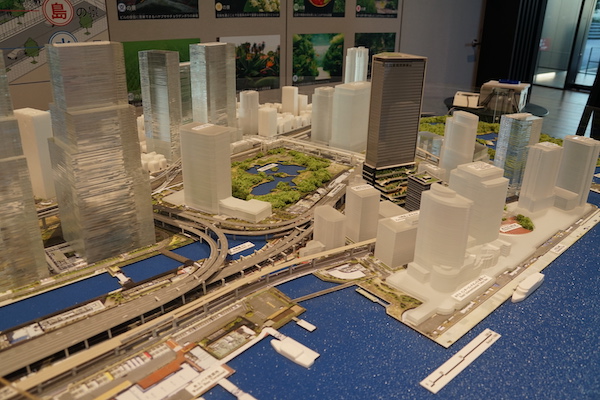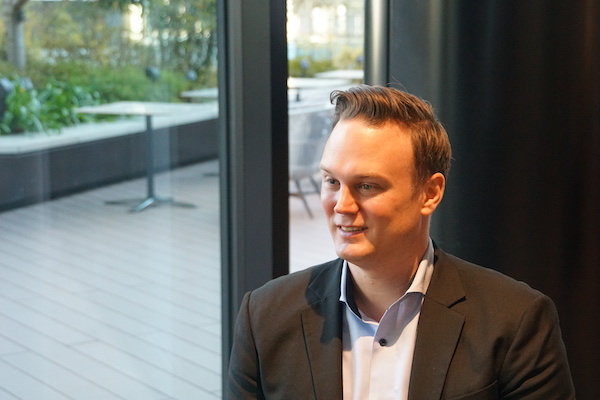Piloting An Offshore Solar Power Plant for the Future Tokyo | Tokyu Land Corporation x SolarDuck Case Study Interview
2023/02/24
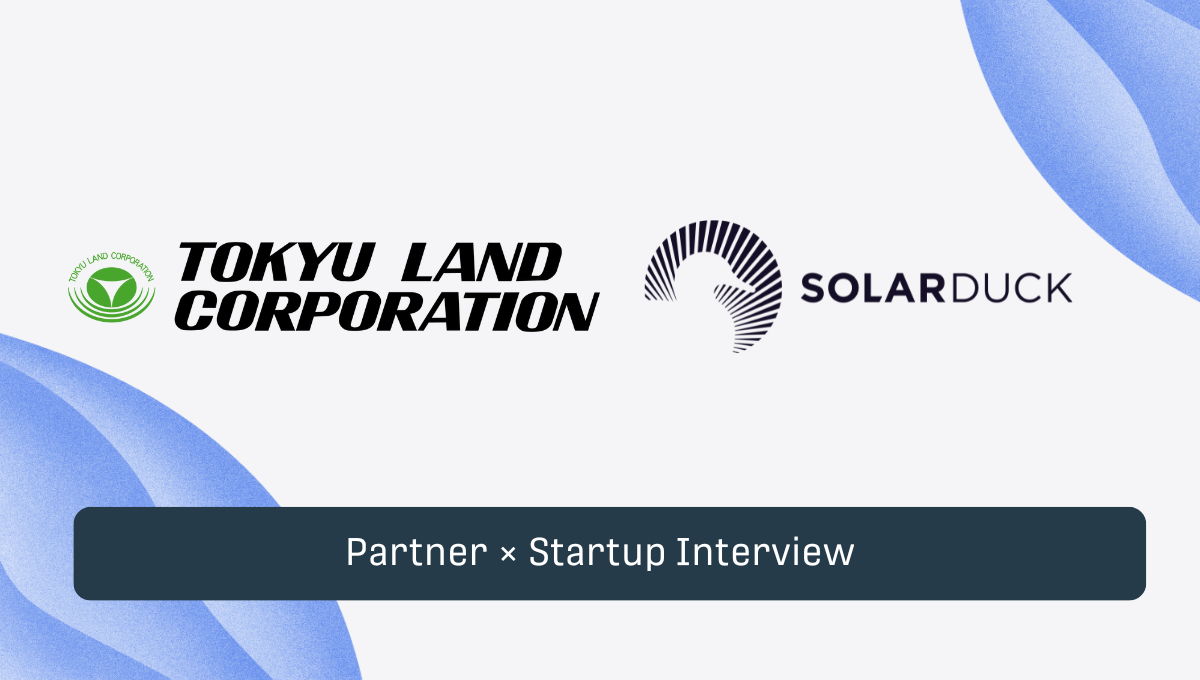
Tokyu Land Corporation and a Dutch industrial player SolarDuck have started a demonstration experiment for Japan’s first offshore solar power generation to find a future solution to improve power self-sufficiency in metropolitan areas of Tokyo. We interviewed the two people in charge of the project to learn more about the background and future vision of the project. (Published on 2/24/2023, Updated on 5/31/2024)
Interviewee : So Watanabe
Deputy Manager, Smart City Promotion Department, Urban Development Division, Urban Business Unit, Tokyu Land Corporation
Interviewee : Olaf de Swart
Co-founder, Head of Business Development SolarDuck
Interviewer: Aldausi Khoirul Rizal
Program Manager, Energy Plug and Play Japan
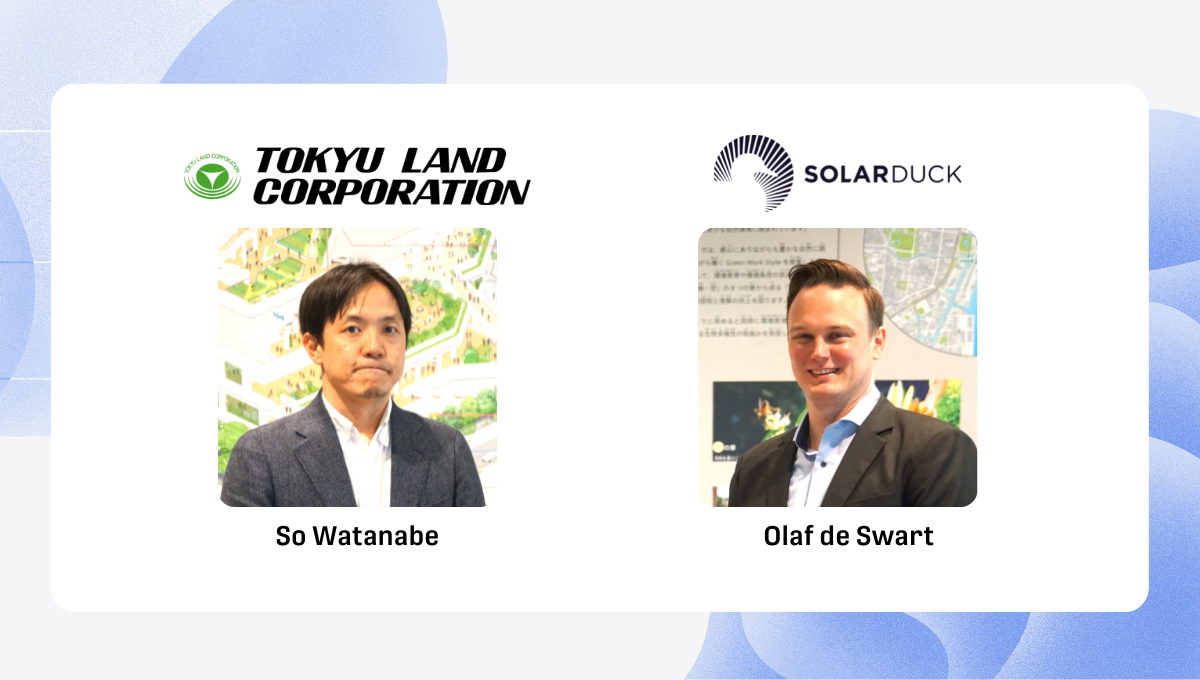
Company Profile
- Tokyu Land Corporation
https://www.tokyu-land.co.jp/english/
Tokyu Land Corporation is a comprehensive real estate business that develops urban, residential, and wellness businesses, including office and commercial facilities. As it expands its business with the keywords of “environment” and “urban development,” it is also actively pursuing initiatives in the environmental field, including the renewable energy business.
- SolarDuck
https://solarduck.tech/
SolarDuck powers the world with clean solar energy. It generates offshore solar energy using state-of-the-art technology. Fully scalable to match specific local requirements worldwide. Offering a sustainable alternative to meet the world’s rising demand for energy. One of their key markets of interest is the hybrid offshore solar market. Last year SolarDuck announced to have successfully entered the HKW offshore wind farm bid together with its partner RWE. There SolarDuck will install the world’s largest hybrid offshore solar farm of 5 MW capacity. In Japan, SolarDuck has been active since 2019, which resulted in the first demonstration project with Tokyu Land Corporation in the Tokyo Bay area. SolarDuck is working hard to strengthen its business locally by establishing an entity in 2023.
Table of Contents
- Background
- Utilizing Plug and Play Japan
- Project Overview
- Challenge
- Cross-Cultural Communications
- Future
Background
--Tokyu Land Corporation (hereinafter TLC) is participating in several programs of Plug and Play Japan. Among the other various fields, what is the reason for your focus on the energy field?
- Watanabe:
When I first joined the program in 2017, I was considering collaborating with startups mainly in the IoT field from the perspective of urban development. But even before that, we were actively working on developing facilities in the energy field, including renewable energies. In addition to the Smart Cities program, we joined the Energy program in 2021 because we wanted to focus more on the energy field, which has been increasingly demanded by society over the past few years.
--Why did you choose offshore solar energy over other renewable energies?
- Watanabe:
We have been working on renewable energy including solar and wind power generation on the land, and we turned our attention to offshore power generation as one of the possibilities. In Japan, there are many examples of solar power generation on water such as ponds and lakes. But as far as I know, there are no examples of offshore solar power generation yet. So we got interested in SolarDuck’s offshore power generation technology as it could also be combined with offshore wind power. We thought that it might be a good fit for the Tokyo Bay eSG project which was publicly offered by the Tokyo Metropolitan Government (TMG), and that’s how we started this demonstration experiment.
--What are some of the advantages of participating in Plug and Play’s Energy Program?
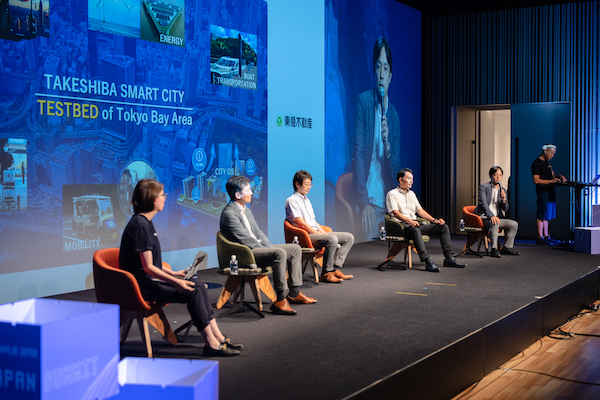
- Watanabe:
I liked the workshops I attended with other corporate partners during the program. I went to several of them, and one of them was about the possibility of collaboration with SolarDuck. It was very insightful to see the various ideas that came up there.
Utilizing Plug and Play Japan
--How did you know about us and what was your initial expectation about our accelerator program?

- De Swart:
In 2019, I came to Japan for the first time. We knew that Japan is one of our key target markets, so I was already trying to build up a network there. I was also searching for accelerator programs in Japan. And then I came across the Plug and Play energy program.
For a young company like us, you have to work together with a large-scale company to be able to commercialize the technology. So we always want to cooperate with interested parties. But it is sometimes very difficult, especially in Japan, to find the right people within the companies. In the setup of the Plug and Play energy program, you get entrances within some of the large Japanese energy players directly on the right level. So that’s an ideal starting point to start investigating if their parties are interested in cooperating with us. That’s indeed where we met TLC.
--From those many partners that you've met during the program, what was the reason you chose TLC as your project partner?
- De Swart:
First of all, TLC is a very innovative company and they are also part of the RE100, which is the global corporate renewable energy initiative committed to 100% renewable electricity. TLC has very aggressive emission reduction targets and focuses both on renewable energies on land and the sea. Taking all that together, that made an ideal candidate to cooperate with us. Besides, there was a project in which TLC had in mind to participate with our technology. So everything came together beautifully.
The Tokyo Bay eSG Project
--Can you give us an overview of the demonstration project?
- Watanabe:
The “Tokyo Bay eSG Project” is a future urban development strategy launched by the TMG to conceive ideal urban design in the next 50 to 100 years. They selected 9 projects, including ours, based on “renewable energy”, “next-generation mobility”, and “environmental improvement”. Our proposal is based on the idea to generate and store energy in a battery and then transporting it by an automated sailboat. In addition to SolarDuck, another startup, Everblue Technologies, is also working on this project with us.
The period of the project is three years until March 2025. The timeline is that in FY2022, design and permitting will be studied and in FY2023, the SolarDuck unit will be installed and start the demonstration. The final year of the project, FY2024, will be the phase in which power generation, storage, and transport will be demonstrated in the secluded space called Chuo-Bohatei (central breakwater).
The site is enclosed and not easily affected by waves, but Tokyo Bay is an area frequently hit by typhoons and other natural disasters, so we would like to verify whether the offshore power generation units can withstand weather fluctuations during the year-long experiment. The experiment will include the actual use of the generated and stored energy in some form for urban development in Takeshiba. We are thinking of usage with low energy consumption. For example, storing electricity in portable storage batteries to connect it to electric motorcycles or using it for a lighting event.

(Image by Tokyu Land Corporation)
--Regarding the technical details, what do you expect from the project?
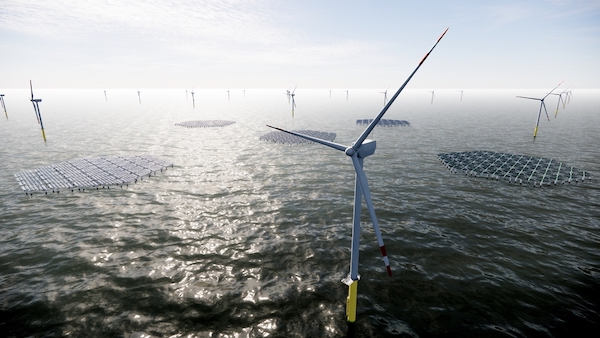
- De Swart:
This project is Japan’s first offshore floating solar energy plant. We hope to show that our technology can survive and resists severe environmental conditions such as typhoons and earthquakes which Japan experiences frequently. Besides that, this project also allows us to investigate what the potential supply chain in the Japanese market would look like and who the potential supply chain partners could be. Because we have to assemble the unit here, we have to purchase some of the components in Japan, transport and assembly them to form a platform, and connect the solar installation to the grid. We would learn the entire product life cycle from A to Z including maintenance and operation of the plant.
--Could you share more details about the volume and the cost to be expected for this project?
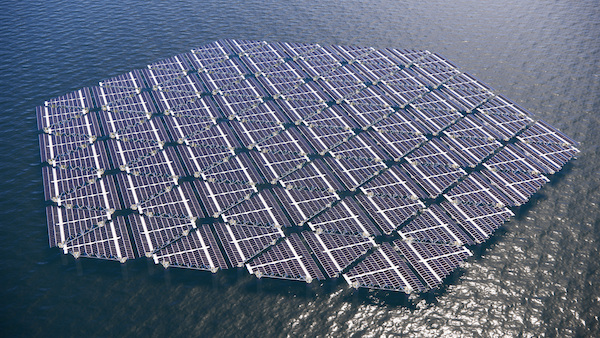
- De Swart:
We currently have one pilot project floating in the Netherlands in a river estuary. We launched that in 2021 and it’s still operating today. It consists of triangular-shaped platforms where the solar modules are elevated above the water surface. The triangles are connected together to form bigger plants. This year around the summer, we will launch the first full-scale demonstration plant on the North Sea. This will have a power output of 500 kilowatt peak in total. The North Sea is a very severe sea, waves of a maximum of 14 meters occur there. If we can make our system work on the North Sea, we can install it anywhere. The technology will at the same time be certified for offshore use. An important step in making the technology bankable.
So for us, the eSG project is the third project in the world. And it will be the first project in a typhoon-prone region. Since a lot of our key target markets are exposed to typhoons, it’s a very important project in our portfolio to show the resistance of our technology. However, the size of the demonstration project is limited, we will be installing a single unit of about 0.1 MegaWatt. Cost reductions will be achieved when the technology is scaled up to larger projects. SolarDuck is already investigating installing large plants in Japan and other typhoon-prone regions. Then we can show the full potential of our technology in the different markets we aim for.
The Challenge
--I think it is necessary to enlist the cooperation of the surrounding community, affiliated companies, and local government. What was or is going to be the most difficult part of this project?
- Watanabe:
The biggest hurdle in the proposal process was how to demonstrate the technological advancement and feasibility of the project within a limited target location and duration. We thought we could utilize our previous Smart Cities projects in the Takseshiba area, and made a proposal to combine power generation and consumption with the use of an auto-navigating sailing boat to transport the power. I think TMG valued the comination aspect as well as the advancement of each technology. Regarding the actual installment, we are now discussing with SolarDuck, TMG, and others to work out the physical issues one by one.
-- Could you share what will be the biggest challenge for this project?
- De Swart:
There are a lot of hurdles to take, which require communication with all the parties involved. The responsibilities of the different parties have to be clear. We communicate weekly or more to make sure that everything is going as planned. If you look at the longer term, regulations will become one of the biggest issues in rolling out this technology. It’s a new market and a new technology, which means there is no regulatory regime yet.
Fortunately, we can take advantage of the policies and structures the offshore wind industry has created over the past several years. Offshore solar power requires all of the same elements as offshore wind power, including sites for plants, financial support systems, and in the longer term, auctions. We can use all those lessons to the benefit of the offshore solar power industry. This means that we can potentially scale up much faster than the offshore wind industry could.
Compared to the offshore wind industry, offshore solar technology has quite some advantages. The required equipment is large and special boats and cranes are required for installation. Even ports have to be adapted to allow for the construction of offshore wind farms. The offshore solar industry does not have those limitations. We use relatively standard-sized ships and small port areas, and we can use local companies for assembly and installation. A lot of those bottlenecks the offshore wind industry had and still has in some markets the offshore solar industry will not experience.
Cross-cultural Communication
--In the communication between two different cultures, did you face any difficulties?
- Watanabe:
In order to work with TMG and other TLC members, we needed to translate English information into Japanese. Also, it was necessary to translate all the Japanese information required for the proposal into English to communicate with SolarDuck. It was not easy to do all there translations in the limited time, but Olaf-san was very kind and friendly and it was easy to communicate with him.
- De Swart:
I think we are aligned well and we communicate very frequently. From our side, we would need a native Japanese speaker in our team in the future. Watanabe-san is so kind to perform all the translation work, but we should also be able to communicate directly with the other parties regarding the assembly or installation. The current bilingual environment can work but it does require quite a bit more effort from all parties involved. It does show the commitment to the project from all parties.
Personally, I don’t see many cultural barriers but that’s maybe also due to the attitude of Watanabe-san, who is very open in communication. And I think that helps to make this project happen. We are a team.
The Future
--Do you have any long-term plans for commercialization or business expansion after the demonstration?

- Watanabe:
Starting from the current development project in Takeshiba, we are thinking about how we can develop business in the Tokyo Bay area to achieve zero emissions which TMG endorces. We are also considering offshore wind power generation in other regions. In the future, there is a possibility that we will work with SolarDuck to complement the offshore wind power fields, and we hope to develop such a combination as a renewable energy business in other areas as well.
--Will the unit you plan to install in Takeshiba be dismantled at the end of the project?
- Watanabe:
We haven’t decided its usage after the end of the project. Although the basic plan is to dismantle it, we would like to use it for another location if possible. The amount of electricity generated by this demonstration unit alone is limited, but we would like to continue the demonstration on a larger scale if possible.
--Do you see any potential in the renewable energy business not only in Tokyo but also in Japan as a whole?
- De Swart:
I think different areas in Japan have different challenges and opportunities. Tokyo Bay is specifically interesting because there’s no opportunity to build an offshore wind plant here on a large scale since the wind speed is low. Of course, land scarcity around Tokyo is very large which means it’s very difficult to provide renewable energy for Tokyo from its surroundings. An offshore solar plant would be an ideal fit. A similar situation is present in other cities like Osaka, Okayama, and Fukuoka.
Secondly, there are opportunities in combining offshore solar energy with offshore wind. This can leverage the existing grid infrastructure. The offshore solar farm can be connected to the same substation and export cable as the offshore wind farm. And the combined energy output of offshore wind and offshore solar is much more stable, such that less energy storage is required to provide energy 24/7/365 days a year.
Tokyo Bay is the location to supply energy in the greater Tokyo area with 30 million people which is one of the biggest metropolises in the world. A lot of power here still is generated by fossil fuels and often imported as well. So there’s a big challenge to make it renewable, enabling Japan to be more energy independent.
It’s ideal to have solar power on a sunny day and when it’s windy, you can have wind power. Potentially combining it with pumped hydro on land acting as a temporary battery and in the future combined with hydrogen to allow for Japan to become fully energy independent. Those are the different business models in Japan that are interesting to explore further.
--Do you see any potential partnership with other energy corporations in the future?
- Watanabe:
As we are essentially a real estate company, we don’t have core technologies for renewable energy. But we think we can set up a place or an environment to execute PoCs or to connect technologies to real sites. We hope that other startups and corporate partners would bring us their needs to execute PoCs, then we could set up this kind of situation to do the test.
I would like to play a role in providing and setting up demonstration sites, not only for the Energy Program partners but also for Smart Cities or Mobility program partners, as I believe there are cases where similar demonstration sites are being sought. We also believe that we can play to our strengths in this way because we are a company that develops its business based on relationships with local governments, primarily in Tokyo. From the perspective of overseas startups, I think it would not be too easy for them to coordinate with the local government, and it would also be difficult to develop discussions with them. We have the advantage of being rooted in this location, so we hope startups can take advantage of that.
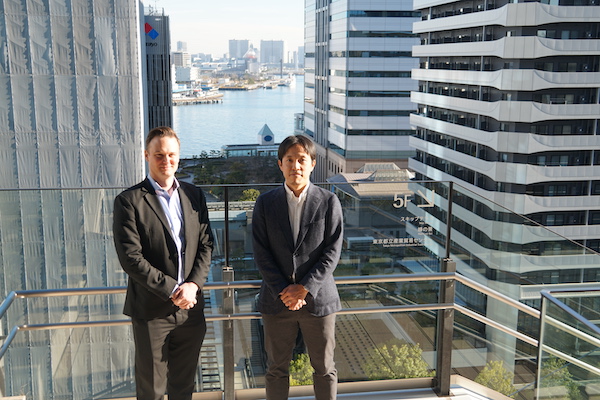
(At Tokyo PortCity Takeshiba)
Update in 2024: SolarDuck Completes Installation of Offshore Floating Solar Power Generation System

In May 2024, SolarDuck’s offshore floating solar power generation facility was installed offshore in the central breakwater area of Tokyo Bay. This marks the start of a demonstration experiment in offshore solar power generation, storage of electricity, and transportation and consumption of storage batteries. The goal is to commercialize offshore solar power generation and build an energy infrastructure model that can be deployed in Japan and other parts of the world.
(Reference: Tokyu Land Corporation news release, May 9, 2024)

